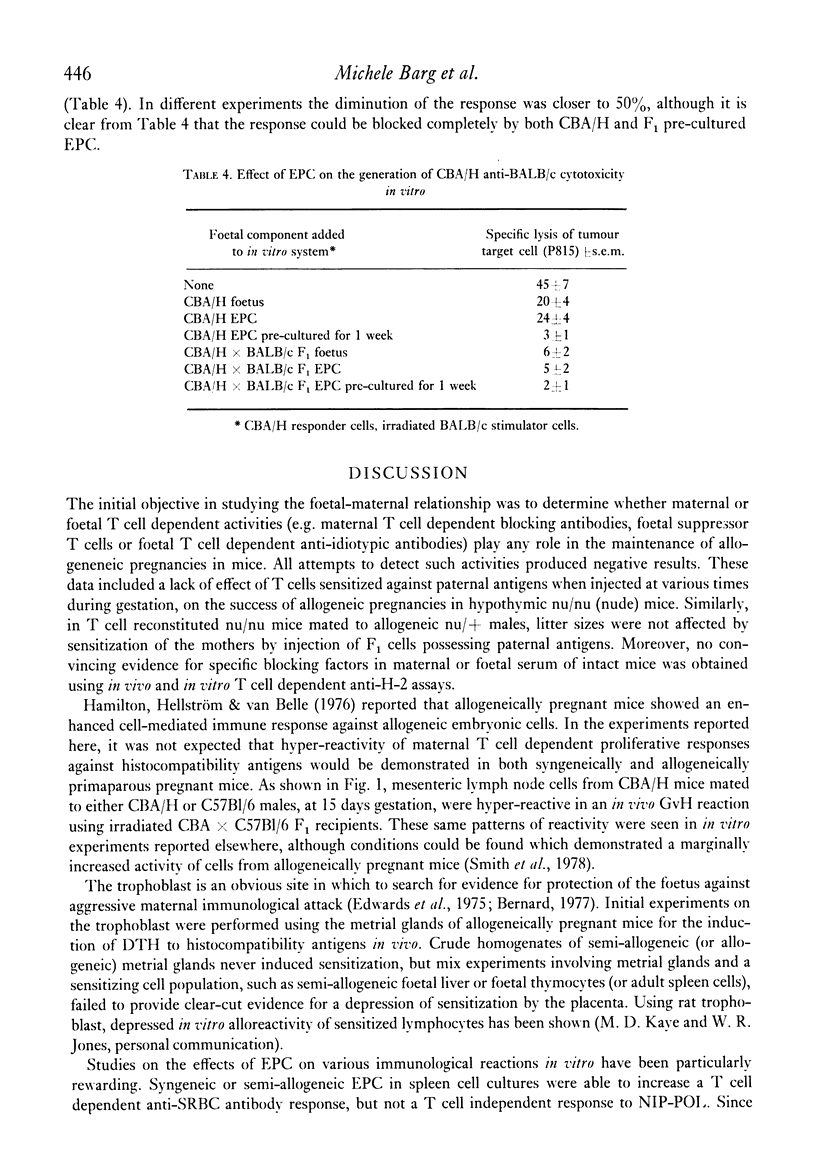Abstract
Using in vivo assays for alloreactivity, the responsiveness of maternal lymph node cells was shown to be increased when cells were harvested from both syngeneically and allogeneically pregnant mice. In addition, foetal liver and thymus cells induced a state of delayed type hypersensitivity to alloantigens whereas trophoblastic tissue, in the form of 12 to 15 day metrial glands, did not.
The influence of mouse placenta on in vitro immune responses was tested using 7-day ectoplacental cones as sources of trophoblastic tissue. Ectoplacental cones increased a T cell dependent but not a T cell independent antibody response, whereas T cell dependent cytotoxicity was reduced. The findings reported in this paper suggest that murine ectoplacental cones are a particularly useful tissue with which to study both specific and non-specific immunological activities of the trophoblast in syngeneic and allogeneic pregnancies.
Full text
PDF







Selected References
These references are in PubMed. This may not be the complete list of references from this article.
- Beer A. E., Head J. R., Smith W. G., Billingham R. E. Some immunoregulatory aspects of pregnancy in rats. Transplant Proc. 1976 Jun;8(2):267–273. [PubMed] [Google Scholar]
- Brownstone A., Mitchison N. A., Pitt-Rivers R. Chemical and serological studies with an iodine-containing synthetic immunological determinant 4-hydroxy-3-iodo-5-nitrophenylacetic acid (NIP) and related compounds. Immunology. 1966 May;10(5):465–479. [PMC free article] [PubMed] [Google Scholar]
- Burton R., Thompson J., Warner N. L. In vitro induction of tumour-specific immunity. I. Development of optimal conditions for induction and assay of cytotoxic lymphocytes. J Immunol Methods. 1975;8(1-2):133–149. doi: 10.1016/0022-1759(75)90090-3. [DOI] [PubMed] [Google Scholar]
- Cunningham A. J., Szenberg A. Further improvements in the plaque technique for detecting single antibody-forming cells. Immunology. 1968 Apr;14(4):599–600. [PMC free article] [PubMed] [Google Scholar]
- Decker J. M., Warr G. W., Marchalonis J. J. A membrane glycoprotein which binds antilymphocyte globulin and concanavalin A is implicated in stimulation of murine T lymphocytes. Biochem Biophys Res Commun. 1977 Feb 21;74(4):1536–1543. doi: 10.1016/0006-291x(77)90617-9. [DOI] [PubMed] [Google Scholar]
- Hamilton M. S. Cell-mediated immunity to embryonic antigens of syngeneically and allogeneically mated mice. Transplantation. 1976 Mar;21(3):261–263. doi: 10.1097/00007890-197603000-00012. [DOI] [PubMed] [Google Scholar]
- Han T. Human chorionic gonadotropin. Its inhibitory effect on cell-mediated immunity in vivo and in vitro. Immunology. 1975 Sep;29(3):509–515. [PMC free article] [PubMed] [Google Scholar]
- Hellström K. E., Hellström I., Brawn J. Abrogation of cellular immunity to antigenically foreign mouse embryonic cells by a serum factor. Nature. 1969 Nov 29;224(5222):914–915. doi: 10.1038/224914a0. [DOI] [PubMed] [Google Scholar]
- Munder P. G., Modolell M., Raetz W., Luckenbach G. A. Primary antibody formation in vitro by mouse cells in a complete homologous system. Eur J Immunol. 1973 Jul;3(7):454–457. doi: 10.1002/eji.1830030715. [DOI] [PubMed] [Google Scholar]
- Palm J., Heyner S., Brinster R. L. Differential immunofluorescence of fertilized mouse eggs with H-2 and non-H-2 antibody. J Exp Med. 1971 Jun 1;133(6):1282–1293. doi: 10.1084/jem.133.6.1282. [DOI] [PMC free article] [PubMed] [Google Scholar]
- Plum J., Thiery M., Sabbe L. Distribution of mononuclear cells during pregnancy. Clin Exp Immunol. 1978 Jan;31(1):45–49. [PMC free article] [PubMed] [Google Scholar]
- Sprent J., Miller J. F. Interaction of thymus lymphocytes with histoincompatible cells. I. Quantitation of the proliferative response of thymus cells. Cell Immunol. 1972 Mar;3(3):361–384. doi: 10.1016/0008-8749(72)90244-4. [DOI] [PubMed] [Google Scholar]
- Vadas M. A., Miller J. F., Gamble J., Whitelaw A. A radioisotopic method to measure delayed type hypersensitivity in the mouse. I. Studies in sensitized and normal mice. Int Arch Allergy Appl Immunol. 1975;49(5):670–692. doi: 10.1159/000231449. [DOI] [PubMed] [Google Scholar]


